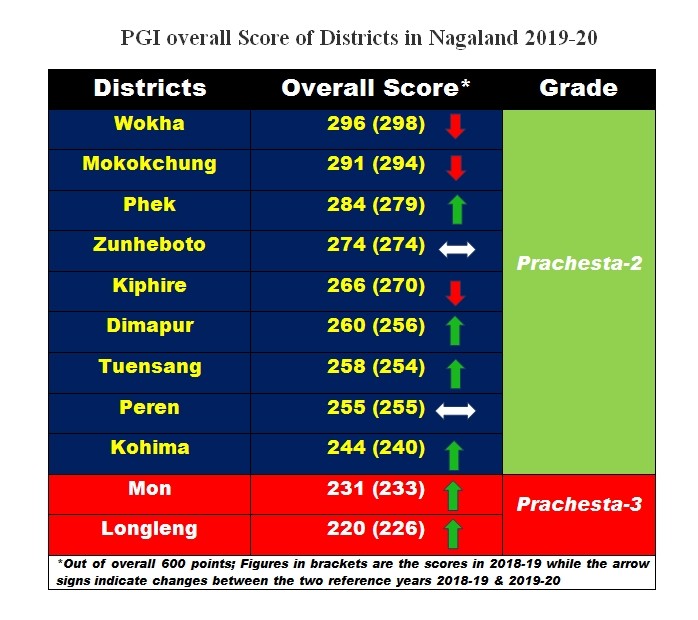
Morung Express News
Dimapur | June 27
All districts in Nagaland performed below average in the Performance Grading Index for Districts (PGI-D) for 2018-19 and 2019-20 released by the Department of School Education and Literacy (DoSE&L), Union Ministry of Education (MoE) on June 27.
The PGI-D assessed the performance of school education system at the district-level by creating an index for comprehensive analysis, an extension of State PGI compiled annually by the (DoSE&L).
As per the index, all the districts in Nagaland were in Prachesta-2 or Prachesta-3, indicating score ranging from 31-50% of the possible points of 600 points.
In 2019-20, out of 11 districts assessed, 9 were slotted under Prachesta-2 or scoring 41% to 50% of the total points.
Wokha led the tally with overall score of 296 (or 49.33%), followed by Mokokchung at 291, and Phek at 284.
Other in districts were Zunheboto (274), Kiphire (266), Dimapur (260), Tuensang (258), Peren (255), and Kohima (244).
The other two districts - Mon and Kiphire were slotted under Prachesta-3 with 231 and 220 points respectively.
Incidentally, Kohima, which was slotted under Prachesta-3 in 2018-19, improved its grading to Prachesta-2 in 2019-20.
Comparison of the two reference years (2018-18 and 2019-20), indicated that there was no significant improvement in the districts’ PGI.
Instead, the top-two performers - Wokha and Mokokchung reflected declines in PGI from previous years, while improvements in other districts were not significant.
It must be noted here that in the overall State PGI Index for 2019-20, Nagaland is slotted in Level VII with a score of 651 – 700 out of 10 levels. Grade-wise, the State scored Grade IV out of 7 grades.
PGI Indicators
According to an official release, the PGI-D was designed to grade the performance of all districts in school education with the objective of helping the state education departments to “identify gaps at the district level and improve their performance in a decentralized manner.”
The PGI-D structure comprised of total weight age of 600 points across 83 indicators, which are grouped under 6 categories: Outcomes, Effective Classroom Transaction, Infrastructure Facilities & Student’s Entitlements, School Safety & Child Protection, Digital Learning and Governance Process. These categories are further divided into 12 domains.
While relatively performing better in Outcomes and Effective Classroom Transaction categories, districts in Nagaland performed worst in terms of Digital Learning, School Safety & Child Protection, and Governance Process.
Grading nomenclature
The report stated that PGI-D grades the districts into ten grades and the highest achievable Grade is Daksh for districts scoring more than 90% of the total points in that category or overall.
None of the districts in India have attained the Daksh Grade in both 2019-20 and 2018-19 implying there is ample scope for the districts to further improve their performance in future years, it said.
The overall scores are then reduced by an equal width of 10% of total points of in that category or overall points for arriving to the next Grade.
Accordingly, the second grade Utkarsh is for the district having score of 81% to 90%; Ati-uttam: 71% to 80%, Uttam: 61% to 70%, Prachesta-I:51% to 60%, Prachesta -2: 41% to 50%, Prachesta-3: 31% to 40%, Akanshi-I:21% to 30%, Akanshi-2: 11% to 20%. The last one, Akanshi-3 is for scores upto l0%.
The position of a district in different grading categories is relative and can change depending upon its performance in each year and the ultimate objective of the exercise is to enable all districts to occupy the highest-Grade Daksh simultaneously, it noted.
The PGI-D 2018-19 comprised of 725 districts where as PGI-D 2019-20 consisted of 733 districts.
According the MoE, the data for PGI-D drawn from several sources, viz., Unified District Information System for Education Plus (UDISE +), National Achievement Survey (NAS) 2017 and data provided by respective districts.
This report is based on voluntary uploading of data by the districts in a reference year and the responsibility for the accuracy of the data filled in the portal rests with the concerned District Education Officer at the district level and the State Project Director (SPD) of Samagra Shiksha at the State level, it noted.






